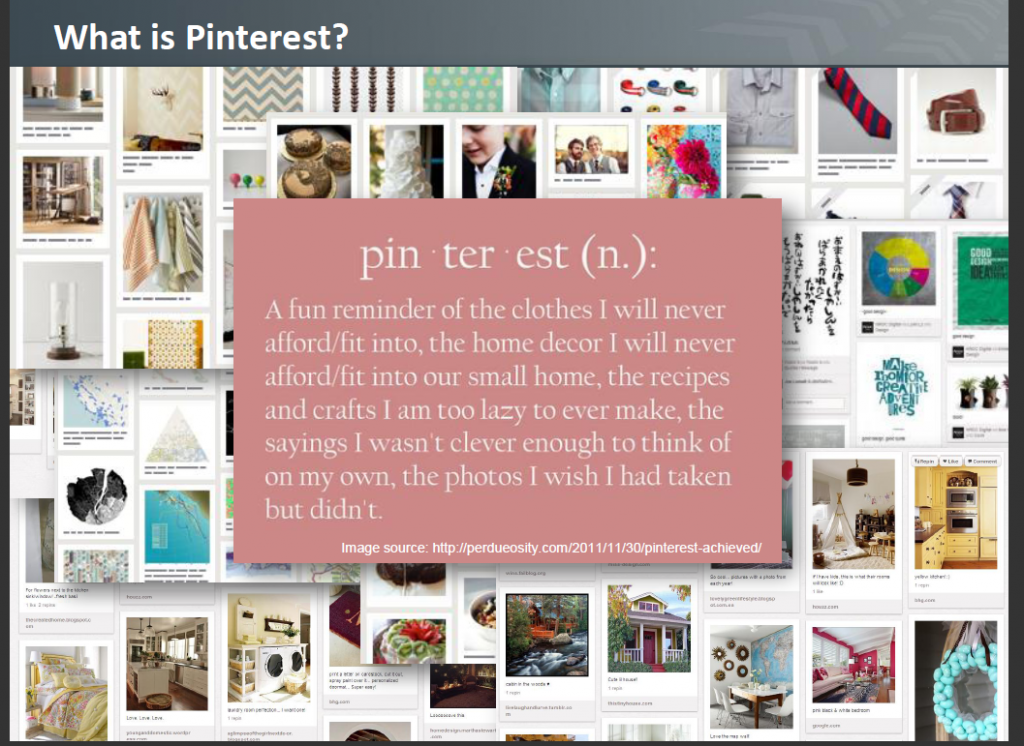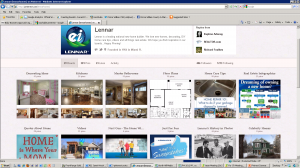
Snarky definition of Pinterest found by Creating Results’ Beth Rand.
Pinterest. At this point, most marketing professionals have heard of this growing social media platform. They may not, however, really understand what Pinterest is. And based on the calls we’ve been fielding from clients and prospects, organizations targeting 50 plus consumers are definitely not sure if Pinterest is right for them.
This week on Mature Marketing Matters, we’ll tell you what Pinterest is, who is using it and give you our thoughts on the possible benefits of the social network to your brand.
What is Pinterest?
Here’s how the network defines itself:
“Pinterest is a Virtual Pinboard.
Pinterest lets you organize and share all the beautiful things you find on the web. People use pinboards to plan their weddings, decorate their homes, and organize their favorite recipes.
Best of all, you can browse pinboards created by other people. Browsing pinboards is a fun way to discover new things and get inspiration from people who share your interests.”
So it’s one part bulletin board, one part showcase for your passions or ideas and one part community. And it’s all visual. Photography – not words – are the way members of this community express themselves.
How Does Pinterest Work?
Pinterest is invitation-only, meaning that you must either be invited by someone or request an invitation directly from Pinterest. Consumers or brands set up an account and then begin “pinning” images. These can be pinned from a website or uploaded from a computer, smart phone, etc. Pins back to websites are trackable.
Then, you create a board. Think of this more as a scrapbook devoted to a single topic. You’ll collect lots of “pins” (images) in your “board.” For example, SouthField, a new master planned community on Boston’s South Shore, has boards for local landscapes and attractions, lifestyle and even 55+ living. Our colleague Amanda Combs has boards for crafts, foods and decorating children’s rooms. Followers can elect to follow all of your boards or specific ones- great insights for gauging areas of greatest interest. Brands can get involved by making it easy for people to pin, as the Loudoun County convention and visitors bureau does on its website.

Or they can create their own Pinterest boards featuring their photography, as Lennar did. Their boards cover a wide range of topics, from Lennar products to the top passions of Pinterest – decorating ideas, inspiring quotes and how-to tips:

Lennar Pinterest boards
How Does Pinterest Integrate with Other Online Marketing?
As noted above, you can add Pinterest as a sharing tool to any website. Pinterest users also frequently choose to have their pins appear in their personal Facebook feed. This means that if a friend – say, our colleague Amanda – takes a liking to one or more recipes with photos of food, these will show up in your Facebook news stream. Good news for brands, as it extends your exposure; bad news for my dieting willpower.
Pinterest also can be integrated with Instagram and WordPress.
Those marketing real estate can benefit from geo-tagging built in to Pinterest, as this reinforces location USPs and can be helpful with SEO.
But Do Pinterest Users Do More than Just Look At Pictures?
There’s no denying Pinterest’s fast growth. Launched in March 2010, by April of 2012 Mashable reported Pinterest had become the third most popular social network in the US, behind Facebook and Twitter.
A widely circulated study by Eloqua reported that Pinterest was responsible for as much referral traffic as Facebook. As much as Facebook! Facebook has 900 million users logging on around the world each day; Pinterest had 104 million visits in all of March 2012.
The jury is split on whether all the Pinterest activity translates into sales. As a terrific post on ReadWriteWeb put it,
“But does referral traffic mean you should push your brand on Pinterest, post haste?
‘It’s not mainstream and about news (Twitter) or socializing (Facebook),’ [Jasmin Bina of JB Communications ] said. ‘Twitter and Facebook are filled with a lot of noise that has nothing to do with products or services, whereas Pinterest is overwhelmingly populated with people sharing the ‘stuff’ that they like – stuff that is often for purchase in some form.’
… ‘However – and it’s a big however – we have yet to see any measurable increase in sales. One logical conclusion is that Pinterest is drawing a certain crowd – a window-shopping crowd,’ [Cathy Tibbles of DSWP Website Services] said.”
What Do You Think?
Is your 50+ consumer-focused brand using Pinterest? What is your focus? How are you measuring success? Please share your thoughts and experiences below.
Tomorrow: Are Baby Boomers and Seniors Interested in Pinterest?


